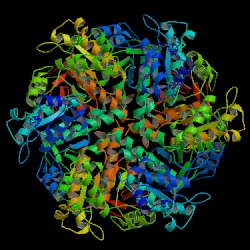DNA repair protein RAD51 homolog 4 is a protein that in humans is encoded by the RAD51L3 gene. [5] [6]
DNA repair protein RAD51 homolog 4 is a protein that in humans is encoded by the RAD51L3 gene. [5] [6]
The protein encoded by this gene is a member of the RAD51 protein family. RAD51 family members are highly similar to bacterial RecA and Saccharomyces cerevisiae Rad51, which are known to be involved in the homologous recombination and repair of DNA. This protein forms a complex with several other members of the RAD51 family, including RAD51L1, RAD51L2, and XRCC2. The protein complex formed with this protein has been shown to catalyze homologous pairing between single- and double-stranded DNA, and is thought to play a role in the early stage of recombinant DNA repair. Several alternatively spliced transcript variants of this gene have been described, but the biological validity of some of them has not been determined. [6]
RAD51L3 has been shown to interact with:

DNA replication licensing factor MCM6 is a protein that in humans is encoded by the MCM6 gene. MCM6 is one of the highly conserved mini-chromosome maintenance proteins (MCM) that are essential for the initiation of eukaryotic genome replication.

DNA repair protein RAD51 homolog 1 is a protein encoded by the gene RAD51. The enzyme encoded by this gene is a member of the RAD51 protein family which assists in repair of DNA double strand breaks. RAD51 family members are homologous to the bacterial RecA, Archaeal RadA ,and yeast Rad51. The protein is highly conserved in most eukaryotes, from yeast to humans.

SUMO-conjugating enzyme UBC9 is an enzyme that in humans is encoded by the UBE2I gene. It is also sometimes referred to as "ubiquitin conjugating enzyme E2I" or "ubiquitin carrier protein 9", even though these names do not accurately describe its function.

Replication protein A 70 kDa DNA-binding subunit is a protein that in humans is encoded by the RPA1 gene.

DNA replication licensing factor MCM7 is a protein that in humans is encoded by the MCM7 gene.

DNA replication licensing factor MCM2 is a protein that in humans is encoded by the MCM2 gene.

DNA replication licensing factor MCM3 is a protein that in humans is encoded by the MCM3 gene.

DNA repair protein XRCC3 is a protein that in humans is encoded by the XRCC3 gene.

Bloom syndrome protein is a protein that in humans is encoded by the BLM gene and is not expressed in Bloom syndrome.

Cell cycle checkpoint protein RAD1 is a protein that in humans is encoded by the RAD1 gene.

Fanconi anemia group G protein is a protein that in humans is encoded by the FANCG gene.

RAD52 homolog , also known as RAD52, is a protein which in humans is encoded by the RAD52 gene.

DNA repair protein RAD51 homolog 2 is a protein that in humans is encoded by the RAD51L1 gene.

RAD51 homolog C , also known as RAD51C, is a protein which in humans is encoded by the RAD51C gene.

Eukaryotic translation initiation factor 2 subunit 2 (eIF2β) is a protein that in humans is encoded by the EIF2S2 gene.

DNA repair protein XRCC2 is a protein that in humans is encoded by the XRCC2 gene.

Coatomer subunit beta is a protein that is encoded by the COPB2 gene in humans.

Eukaryotic translation initiation factor 3 subunit G (eIF3g) is a protein that in humans is encoded by the EIF3G gene.

Vacuolar protein sorting-associated protein 28 homolog is a protein that in humans is encoded by the VPS28 gene.

E3 ubiquitin-protein ligase FANCL is an enzyme that in humans is encoded by the FANCL gene.